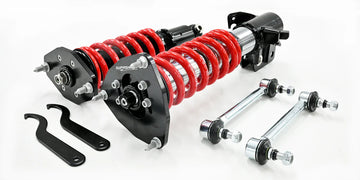Coilovers are a crucial component in shaping the ride quality and handling dynamics of a vehicle. These sophisticated suspension systems integrate coil springs and shock absorbers into a single unit, offering adjustable ride height, damping settings, and spring rates.
By fine-tuning these parameters, drivers can tailor their vehicle's characteristics to suit specific driving conditions; such as motorsports or off-roading. Keep reading to find out how this works in more detail.
How do coilovers affect ride and handling?
Coilovers influence ride and handling in several ways:
Ride height
Coilovers provide drivers with the ability to adjust their vehicle's ride height. This adjustment not only impacts the aesthetic appeal of the vehicle but also plays a crucial role in its overall performance. By lowering the ride height, the centre of gravity is reduced, leading to improved handling characteristics such as reduced body roll during cornering.
Additionally, lowering the vehicle can enhance aerodynamics, which can positively affect fuel efficiency and high-speed stability. Conversely, raising the ride height can improve ground clearance, making the vehicle more capable off-road or in challenging terrain.
Spring rates
The spring rates of coilovers refer to the stiffness or softness of the coil springs integrated into the suspension system. Firmer spring rates provide a more sporty feel, as they resist compression more aggressively, thus reducing body roll and improving handling, especially during aggressive driving manoeuvres like cornering.
On the other hand, softer spring rates absorb bumps and imperfections in the road more effectively, leading to a smoother ride quality. The choice of spring rates often depends on the driver's preferences, driving style, and intended use of the vehicle.
Damping adjustments
Coilovers are equipped with adjustable damping settings, which allow drivers to fine-tune the suspension's response to varying road conditions. Damping refers to the resistance provided by the shock absorbers against the movement of the suspension.
By adjusting damping settings, drivers can optimise the suspension for comfort during daily commuting or firm it up for enhanced performance during spirited driving. Proper damping is crucial for maintaining optimal tire contact with the road surface, ensuring consistent grip levels and precise handling, especially when navigating corners or uneven terrain.
Cornering stability
One of the key benefits of coilovers is their ability to enhance cornering stability and agility. By lowering the vehicle's centre of gravity and minimising body roll, coilovers improve the vehicle's responsiveness during cornering manoeuvres.
This translates to a more planted and confident feel, allowing drivers to push the limits of their vehicle's handling capabilities with greater ease. Enhanced cornering stability is particularly beneficial during spirited driving or on winding roads, where precise control and confidence-inspiring handling are paramount.
What are the parts of a coilover and how do they work?
Coil springs
A coil spring is a type of mechanical spring commonly used in various applications, including automotive suspension systems, industrial machinery, and household items. It consists of a spiral coil of metal wire with consistent diameter and pitch.
Here's how a coil spring works:
- Supporting Weight: The primary function of a coil spring is to support and distribute the weight of an object. In automotive applications, coil springs support the weight of the vehicle, including the chassis, body, passengers, and cargo.
- Compression and Extension: When a force is applied to a coil spring, such as the weight of a vehicle pressing down on the suspension, the spring compresses or shortens. This compression stores potential energy in the spring. When the force is removed or reduced (e.g., the vehicle moves over a bump), the spring extends or returns to its original length, releasing the stored energy and absorbing the impact.
- Spring Rate: The spring rate, also known as stiffness or elasticity, refers to how much force is required to compress the spring by a certain distance. It is typically measured in pounds per inch (lb/in) or newtons per millimetre (N/mm). A higher spring rate means the spring is stiffer and requires more force to compress, while a lower spring rate indicates a softer spring that compresses more easily.
Shock absorbers
Shock absorbers, also known as dampers, are crucial components of a vehicle's suspension system. Their primary function is to control the movement of the springs, managing the energy absorbed during compression and extension to ensure a smooth and controlled ride.
Here's how shock absorbers work:
- Absorbing Energy: When a vehicle encounters bumps, potholes, or uneven road surfaces, the suspension springs compress to absorb the energy of the impact. This compression generates kinetic energy within the springs.
- Damping Movement: As the springs compress, hydraulic fluid or gas inside the shock absorber is forced through small passages or valves, creating resistance. This resistance slows down the movement of the suspension and dissipates the energy as heat.
- Rebound Control: In addition to damping compression, shock absorbers also control rebound, which is the extension of the suspension after compression. By providing controlled resistance during both compression and rebound phases, shock absorbers help maintain tire contact with the road surface, improving traction, stability, and control.





